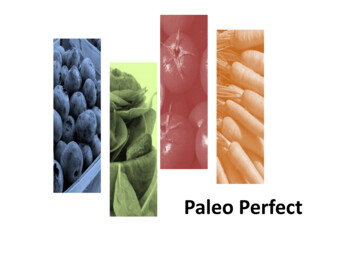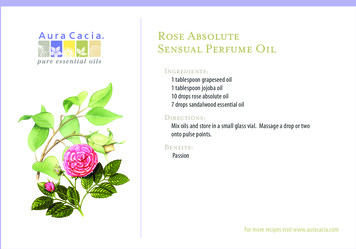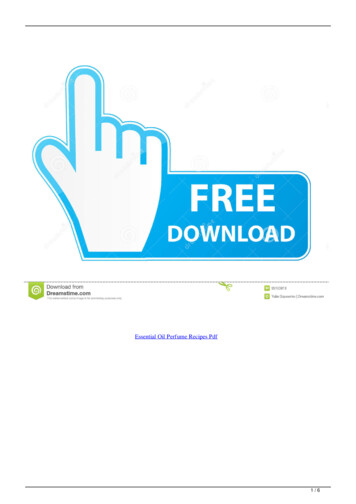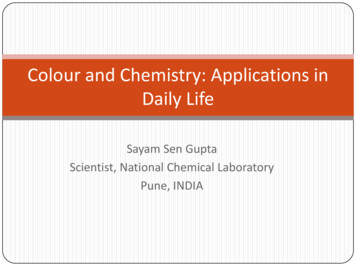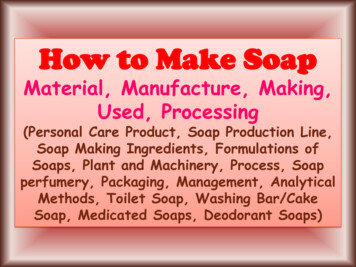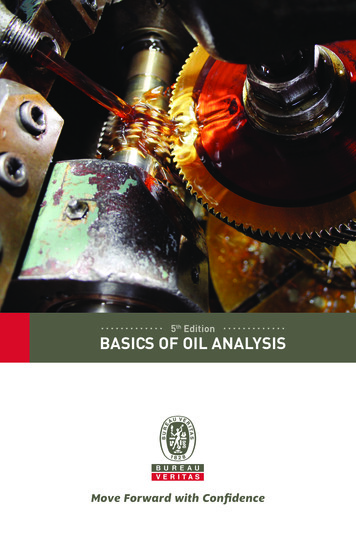
Transcription
5th EditionBASICS OF OIL ANALYSIS
CONTENTSIntroduction3Keys to Successful Oil Analysis5Establishing an Effective Oil Analysis Program7Tests and Their Significance19
The Evolution of an IndustryFor decades, oil analysis has helped diagnose the internal condition of oil-wettedcomponents and their lubricants in virtually every industry that involves heavyduty machinery or stationary industrial equipment. While early test methods wereshockingly simple, present-day processes employ the most advanced analyticaltools and technologies.Commercial oil analysis uses a combination of physical and chemical tests tomonitor component wear, lubricant condition and contamination. These tests areestablished and continually reviewed by a number of global agencies, includingthe International Organization for Standardization (ISO), the American Societyfor Testing and Materials (ASTM) and the Society of Automotive Engineers (SAE).Additionally, a variety of laboratory and personnel certifications have emerged toensure the highest levels of testing and analytical quality.We have designed this book to help our oil analysis customers improve theirmaintenance programs with a better understanding of both the oil conditionmonitoring concept and the fundamentals of a world class oil testing and analysisprogram based on industry best practices.The Bureau Veritas Value PropositionOptimal equipment performance starts with consistentmachinery fluid testing and analysis. The Bureau Veritasglobal network of state-of-the-art testing facilitiesprovides accurate, reliable results you can depend on tokeep your machines up and running.Together, our customer-driven reporting tools andsolutions-oriented data analysts take those qualityresults a step further, bridging the gap between gooddata and good business decisions. Allowing for effectivemonitoring of equipment conditions, these toolsempower you to take decisive maintenance actions thatmaximize uptime and boost production levels.BUREAU VERITAS3
Why Test With UsData management solutions that keep you ahead of critical maintenance events.With Bureau Veritas’ exclusive Lube Oil Analysis Management System (LOAMSSM),maintenance personnel can optimize equipment reliability and productivity usingreal time oil analysis data to: Manage equipment around the globe in one centralized database Monitor changes in machine condition across an entire plant or fleet to identifyminor problems before they become catastrophic failures Streamline communications to get the right information to the right people atthe right timeA partnership with experienced data analysts whose informed maintenancerecommendations are based on equipment-specific knowledge. Rely on smart analytical systems that differentiate between normal samplesand those that require more in-depth communication with an analyst Accurately interpret test results to quickly identify an immediate plan of actionin critical situationsEngagement with a staff of laboratory professionals that takes a personalinterest in adding true value to the Bureau Veritas oil analysis experience. From ordering test kits to interpreting results to managing the data, BureauVeritas provides customer-focused solutions for maintaining equipmentreliability through expert fluid analysis Competent customer service representatives, free training webinars and adedicated LOAMS Help Desk allow you every opportunity to maximize yourinformation and create a positive impact on your company’s bottom lineBureau Veritas employs more than 66,500 employees in 1,400 offices andlaboratories in 140 countries. We serve more than 400,000 clients around the worldthrough our eight global businesses, which include Marine & Off-Shore, Industry,In-Service Inspection and Verification, Construction, Certification, Commodities,Consumer Products and Government Services and International Trade.Our oil analysis services are positioned within the Bureau Veritas Commoditiesbusiness line, which provides a wide range of inspection and laboratory testingservices for all types of commodities: Oil & Petrochemicals, Oil ConditionMonitoring, Metals & Minerals, Exploration & Mining, Coal and Agri-Commodities& Fertilizers.4BASICS OF OIL ANALYSIS
KEYS TO SUCCESSFUL OIL ANALYSISA successful oil analysis program requiresan organized and sustained effort. Nopreventive maintenance initiative will reachits goal without integrating processes forcontinued improvement and a consciouseffort by both user and laboratory to worktogether in all aspects of the programto achieve optimal machine health andreliability. These proven steps are key.
1Clearly define program goals and requirements to besure the test packages utilized are appropriate for theapplication and the service is being fully utilized on aregular, on-going basis.Take representative samples that are indicative of thetrue condition of the lubricant and the component sothat the testing and analysis performed is accurateand reliable.3Promote frequent, two-way communication betweenlaboratory and customer to optimize both laboratoryinterpretations and recommendations as well ascustomer diagnostics and maintenance action.Provide complete and accurate sample informationso that data analysts may provide an accurateinterpretation of the test results with wellinformed, actionable maintenance or diagnosticrecommendations.56BASICS OF OIL ANALYSIS24Review test reports promptly to be sure abnormal orcritical machine or lubricant conditions are addressedquickly and equipment damage and production lossesare minimized.
ESTABLISHING AN EFFECTIVE OILANALYSIS PROGRAMOil analysis is an integral part of themaintenance plan for power generationand manufacturing plants, over-the-roadtrucking fleets, off-road constructionequipment, HVAC and refrigeration systemsand processing and chemical plants. Anypiece of equipment that has a lubricatingsystem is a potential candidate for oilanalysis.
Determine Primary Program ObjectivesOil analysis can be applied to equipment and lubricant utilization, maintenanceand management.Utilization Decrease unscheduled downtimeIncrease overall component lifespanControl lube consumption and oil disposal costsAssist with product selection, comparison and verificationMaintenance Identify and quantify lube contamination and component wear for targetedcorrective action Reduce in-service failures and field repairs Establish proper lubricant service intervalsManagement Improve reliability, product quality and productivityImprove cost control for equipment, labor and materialsEliminate needless inspections or repairsControl spares and replacement costsCarefully Consider The Best Choice For An Oil Analysis ProviderThe best choice for an oil analysis provider is a laboratory prepared to help youachieve the primary goals and objectives of your testing program. The laboratoriesyou consider should be equipped with state-of-the-art instrumentation, robustdata management solutions and staffed with well-trained, experienced techniciansand data analysts that can be available to address your questions.Quality Testing, Data Interpretation & AutomationBureau Veritas laboratories operate according to the highest standards for testingand calibration laboratories. Each of our US laboratories is ISO 17025 accreditedwith a scope of testing among the most comprehensive in the industry. ISO 17025accreditation, with this level of inclusion, is a testament to top management’scommitment to greater quality awareness, accuracy and continuous improvement.8BASICS OF OIL ANALYSIS
We staff our laboratories with experienced data analysts who have theequipment-specific knowledge to make well-informed, actionable maintenancerecommendations. They hold both Certified Lubrication Specialist (CLS) andOil Monitoring Analyst (OMA) certifications from the Society for Tribologists andLubrication Engineers and the International Council for Machinery Lubrication.By partnering with the leading instrument manufacturers and participating inthe development of industry-specific standard test procedures, Bureau Veritas isin touch with the latest technological advances. Our commitment to continuousprogress and advancing technology results in value-added testing, the latest inautomation and the highest levels of efficiency.A Partnership in Data AnalysisBureau Veritas makes substantial investments in the advancement of technologiesthat continually improve the benefits of oil analysis for our customers. Our selflearning data analysis system provides a comprehensive evaluation of normalsample results based on a database of like sampling histories, sampling points andthe maintenance recommendations applied to them. This allows our data analyststo address critical samples and work closely with those customers to providethe diagnostic and maintenance recommendations necessary for preventingcatastrophic equipment failure.Online Applications for Optimizing Oil Analysis DataOur Lube Oil Analysis Management System – LOAMS – not only provides customersquick access to test reports but also offers a full range of data management toolsfor managing every aspect of a world class oil analysis program. Key featuresinclude simplified sample submission, graphical trend analysis, management anddiagnostic reporting, global equipment management and easy results distributionand communication.Equipment & Sample Report Management Keep equipment lists clean and sampling histories intact with the power toadd, delete, update, merge and move units between locations Maintain scheduled sampling intervals Print bar-coded jar labels and register trackable sample information onlineprior to the sample’s arrival at the laboratory Create custom search filters to easily locate data using multiple equipmentparameters Save filters to quickly locate commonly viewed test results and download, printor email to othersBUREAU VERITAS9
Trend Graphing Track trends in abnormal test results for individual pieces of equipment usingmultiple test parameters Overlay test results by make or model to compare equipment performancebetween individual units or across populations of units Chart sample condition for specific components to view performance comparedto similar models or families of component typesManagement ReportsFluid analysis only saves you money if you are saving equipment. The managementreports within LOAMS provide a comprehensive view of all your fluid analysis data. Document your program’s strengths and eliminate its weaknesses to elevateoverall program performance Know that samples are shipped to the laboratory as soon as they are taken Monitor sample transit time to pinpoint issues that could be slowing turnaroundtime and costing you money in delayed maintenance action Enforce compliance with required sampling schedules to catch small problemsin all of the components you are testing before they become catastrophicfailures Address critical samples immediately and monitor those at lesser severitiesfor changes in sample condition – trend analysis is key to achieving “normal”sample results across the board, which is the true measure of a successfulfluid analysis programDiagnostic ReportsThe diagnostic reports within LOAMS are designed to identify equipment-specificissues. Contamination, wear and fluid degradation are the most common causesfor equipment failure and the top three reasons for monitoring both fluid andequipment condition. Track the generation of wear metals, dirt ingression, fuel dilution and coolantleaks - the biggest concerns for engine health in heavy duty applications High cleanliness standards, extreme operating conditions and highreplacement costs make it necessary to monitor acid number, viscosity andparticle contamination in many industrial applications.Together, the management and diagnostic reporting capabilities in LOAMSgive users quick access to comprehensive data that can elevate a fluid analysisprogram to higher levels of performance. Documenting the cost savings of a highperformance fluid analysis program can justify the maintenance budgets necessaryfor successfully managing a world class sampling program.10BASICS OF OIL ANALYSIS
System Configuration & Administration Designate roles, permissions and preferences to determine how data isreceived, displayed and communicated to othersCommunications & Distributions Utilize filters to automate email distributions of sample reports andmanagement reports specific to other LOAMS users and non-usersTechnical Support Help icons on each menu tab explain the tab’s functionality Quick Links give users access to detailed training videos, quick start guidesand Frequently Asked Questions The LOAMS Help Desk is available to demonstrate LOAMS features or answerquestions at 1.800.655.4473 or loams@analystsinc.com.Build A Strong Program Foundation Before Testing BeginsProviding as much relevant, accurate machine information to the laboratory aspossible is imperative for receiving quality, in-depth analysis of the test data.Laying the proper groundwork dramatically increases the value – and the success– of any oil analysis program.Unit CriticalityAssessments that consider criticality to production and cost of repair andreplacement should be used to help define the units to be tested. Theseassessments should also be based on operational history or known wear issues.Once these units have been identified, all relevant unit information should beaccurately recorded and communicated to the laboratory – unit ID, make, model,lube type and hours/miles as all of this information has significant impact on theinterpretation of test results.TestingSpectrochemical analysis and physical property tests are used to assess thecondition of both lubricant and machine condition and should be performedaccording to a unit’s criticality to production or a pre-determined preventivemaintenance schedule. Physical tests focus on measuring specific lubricantcharacteristics such as viscosity, the formation of degradation byproducts, acid andbase number, while spectrochemical analysis measures concentrations of wear,contaminant and additive elements. Bureau Veritas has developed multiple testpackages to cover the general testing needs of broad industry classifications suchas Power Generation, Manufacturing, Construction, Mining and Transportation.While these packages meet most testing needs, test slates can be customized tomeet specific program goals and objectives.BUREAU VERITAS11
Industrial Premium Test PackageComponentsTestDiesel / Nat. GasEnginesGear Systems /MotorsCompressors /BearingsHydraulic /TurbineMetals Analysis(Wear Metals,Contaminant Metals,Additive Metals) Viscosity (100 C) (Water %) Viscosity (40 C)FTIR (Fuel Dilution,Fuel Soot, Glycol,Oxidation, Nitration)Water byKarl Fischer (ppm)Base Number (TBN)Acid Number (TAN) ISO Particle Count(PQ)Heavy Duty Premium Test PackageComponentsTestDiesel / GasolineEnginesNatural GasEnginesNon-Engine(Transmission,Differential, etc.)HydraulicElemental Analysis(Wear, Contaminant& Additive Elements) Viscosity (100 C) Viscosity (40 C)FTIR (Fuel Dilution,Fuel Soot, Glycol,Oxidation, Nitration)Water %Base Number (TBN) Acid Number (TAN)PQ Index12BASICS OF OIL ANALYSIS
Sampling IntervalsUpon program implementation, all units/components included in the criticalityassessment should be sampled to establish initial baseline data and identifyany serious existing component issues. Both client and laboratory together canthen determine proper routine sampling intervals based on the results of thepreliminary work, component manufacturer guidelines, the client’s maintenanceprocedures and laboratory experience with similar components and applications.General Sampling Interval RecommendationsUnit TypeRecommended Sampling FrequencyRoutine UseIntermittent UseDiesel EnginesGasoline / LPG Engines15,000 miles / 250 hours5,000 miles / 150 hoursQuarterlyNon - Engines30,000 miles / 500 hoursQuarterlyDiesel EnginesGasoline / LPG Engines250 hours / monthly150 hours / monthlyQuarterlyNon - Engines500 hours / monthlyQuarterlyMain EnginesSupport Engines250 hours / monthly150 hours / monthlyQuarterlyNon - Engines500 hours / monthlyQuarterly500 hours / monthly250 hours / monthlyQuarterlyCompressors, Steam Turbines250 hours / monthlyQuarterlyGeared Drives, Bearings500 hours / monthlyQuarterlyHydraulics500 hours / monthlyQuarterlyPiston EnginesTurbine Engines50 hours / at oil change150 hoursOil change, 100 hour inspection &annualGeared Drives350 - 500 hours100 hour inspectionHydraulics150 - 250 hours100 hour inspectionMobile Equipment(On Road)Mobile Equipment(Off Road)MarineIndustrial / StationaryDiesel / Natural Gas EnginesGas TurbinesAviationRefrigerationChillers (all refrigerant types)Beginning, Middle, End of SeasonBUREAU VERITAS13
Obtaining Representative SamplesIf a sample does not represent the actual condition of the lubricant and thecomponent during operation, the reliability of both the test results and theirinterpretation is affected. Taking samples at regularly scheduled intervals andduring normal operating conditions or within 30 minutes of shutdown allows foraccurate trend analysis and the proper evaluation of any change in lubricant andcomponent condition as wear particles and contaminants will remain thoroughlymixed and suspended.Sampling from the sump or at the reservoir drain is the least recommendedmethod for taking samples as wear particles and contaminants that tend to settlein these areas are not indicative of the concentrations present during operation.We recommend the following sampling methods and locations.A permanent sampling port provides aconsistently accurate sample collection sourceand is applicable to both pressurized and nonpressurized systems.Samples drawn from a common return linecollection point provide superior accuracywhen the valve is installed upstream of thefilter. This is the best sampling method forassessing machine contamination.A petcock valve or similar sampling device is permanently installed upstream of anyfilters. A vacuum pump draws fluid through tubing and into the sample jar.14BASICS OF OIL ANALYSIS
Consistent Baseline InformationInitial equipment registration is easily accomplished by furnishing the laboratorywith a consolidated equipment list based on a thorough survey of the machinesand systems to be sampled or by completing an individual registration form thefirst time each unit is sampled. In either case, the sampling point ID and currentoperating data is sent with each sample. To complete our sample processingforms and sample container labels completely and accurately, the following datais crucial for the laboratory to provide an accurate analysis of the test results andreliable maintenance recommendations: Unit IDThe Unit ID is a reference number for an entire unit. Examples include acompany asset or inventory identification number or vehicle serial number. Unit Manufacturer & ModelManufacturer & Model allows an analyst to identify specific componentmetallurgies and confirm wear metals present in the sample. ComponentComponent represents the type of oil-wetted system being sampled – engine,hydraulic, gearbox. Our forms also provide designations for common samplingpositions – left, number 3, rear – or an actual description of the component’suse – fan drive, winch, swing – for clear, more precise identification.NOTE: In industrial applications, “unit” and “component” often refer to thesame mechanical system. In these cases, the description of the sampledsystem should be recorded as the “unit.” Time Since New or Last OverhaulSince normal wear rates change over the lifetime of a component and breakin may resemble abnormal wear, the operating hours or miles since thecomponent was first put into service or since the last overhaul or rebuild cangreatly affect interpretation of the test results. This data may be obtained fromthe component’s service meter or from general operating records. Time Since Last Oil ChangeThis is the number of hours or miles of component use between the time theoil was last changed and the time the sample was taken and is essential totime-based trend analysis. Oil TypeThe manufacturer, complete product name and viscosity grade for the oilsampled is important for proper interpretation. Oil Consumption or Make-Up OilComplete oil changes should not be reported as make-up oil or identified as“new oil.” Consumption or make-up oil is the amount of oil added to maintaina correct oil-fill level in the sampled component.BUREAU VERITAS15
A sample may not be processed immediately if the client name, unit and componentidentification or sample date are not provided with the sample. Having sampledthe unit before does not ensure that the unit and component identifications matchthe information provided with previous samples submitted for that unit. Testingcould be delayed until this information is obtained or the results may not be filedcorrectly with other samples from that unit.Any recent maintenance, changes in performance or unusual operating conditionspertaining to the unit should be included with the sample as well as any informationcollected during other routine maintenance and servicing activities.Program PersonnelAll personnel involved in implementing and maintaining an oil analysis programas part of any maintenance initiative should be trained on each of these importantaspects which are vital to a program’s continued success: Taking representative samples Recording consistent, complete and accurate oil and component informationfor sample processing Sending samples to the laboratory as soon as they are collected Using any online data management tools provided by the laboratory for optimalequipment management and to achieve maximum machine performance andreliabilityUnderstand Data Interpretation & Maintenance RecommendationsOur interpretation and evaluation of laboratory test results typically separates theoverall component and fluid condition – as relative to the severity of contaminationand wear – into four main classifications:NORMALPhysical properties of the fluid are within acceptable limits and no signs ofexcessive wear or contamination are present.MONITORSpecific test results are outside acceptable ranges yet are not considered seriousenough to justify diagnostic action. However, caution is advised as the initialstages of an abnormality often show the same pattern of results as do temporaryconditions, such as extended usage or overloading.16BASICS OF OIL ANALYSIS
ABNORMALPhysical properties, contamination and/or component wear are clearlyunsatisfactory but not critical. A confirming sample is recommended. Additionaldiagnostics may be necessary to confirm all sample conditions and correctiveactions could be necessary to prevent reduced service life or overall loss ofperformance.CRITICALLubricant physical properties, contamination and/or component wear is clearlyserious enough to require immediate diagnostic and/or corrective action to preventmajor long-term loss of performance or component failure – short-term loss ofperformance may already be present. Operating hazards are likely to increase andlarge-scale repairs may be required. Recommendations may include removing theunit from service until a re-sample or other recommended diagnostics confirmthat repairs are necessary.Clients are contacted immediately by phone on all samples the laboratory classifiesas “critical.” LOAMS users can designate within the application to have reportsat specific severity levels emailed to them which include recommendations fromour experienced data analysts for taking immediate maintenance action to correctboth the problem and the cause.NOTE: Sample severity assessments are relative and are assigned using both trend analysisand condemning limits.In the trend analysis of wear elements, threshold values are developed to identifythe boundary areas between normal and abnormal results. These values can varyby component type, application, length of service and manufacturer/model anddon’t provide sharp lines of “normal/abnormal” interpretations. Instead, theyindicate ranges of increased probability for a developing issue.Generally, the lubricant and component condition can be considered “normal” aslong as the wear, contamination and lubricant deterioration levels remain withinestablished “normal” ranges. Regardless of threshold values, any sharp increasein wear metals or major shift in physical properties can signal the beginning of aproblem. Therefore, threshold values cannot be used as “go/no go” criteria andshould not be developed or applied without a great deal of caution, judgment,experience and client input.REMEMBER: Always request clarification of the test results or data analysis if you don’tunderstand them Familiarize yourself with the laboratory’s severity classifications so that youknow which units you can continue to monitor and which units need immediatemaintenance attention Establish alarm limits specific to your equipment needs, if necessary Review test reports and act on maintenance recommendations in a timelymannerBUREAU VERITAS17
Provide The Laboratory With FeedbackThe accuracy of the laboratory’s interpretation guidelines is verified by thecomparison between laboratory maintenance recommendations and the actualconditions confirmed by the customer’s diagnostic inspection. While these datainterpretations are continually refined by practical experience, the followingcustomer feedback is extremely helpful when included on the sample informationform: Suspect abnormal lubricant or component conditions Findings of any inspection performed as a result of oil analysis programrecommendations Discovery of abnormal machine conditions that were not previously indicatedby oil analysis Notification of servicing and/or maintenance performed Information concerning operating environment or equipment applicationchangesMeasure Program Cost EffectivenessRoutine oil analysis can achieve substantial savings in maintenance and repaircosts by detecting small problems before they develop into serious or catastrophicmaintenance events. The economic savings from oil analysis may not show clearlyon the “bottom line” because they represent the cost maintenance events thatwere prevented. However, many of these savings can be calculated by comparingthe cost of a testing program to: Parts and labor expenses for component repair, overhaul or replacementLosses in revenue during downtimeReductions in consumable items, such as lubricants or fuelsIncreases in productivity levelsBecause a well-run oil analysis program is deeply integrated within a company’soverall maintenance program, program managers must establish a strongplatform for measuring, documenting and distributing to upper management thecontribution oil analysis makes to profitability.18BASICS OF OIL ANALYSIS
TESTS AND THEIR SIGNIFICANCEWithout a working knowledge of oil analysistests and the reasons for performing them,users may be uncertain as to their value andhow they relate to each other in providinga useful, accurate picture of internalcomponent and lubricant condition.We consider the following oil analysistests as the most important for optimizingmachine health and reliability in bothindustrial and heavy duty applications.
Spectrochemical AnalysisWear, contaminant and additive elements present as dissolved solids andmicroscopic particles suspended in the fluid are identified and measured inparts per million by weight. The analyzed elements are grouped into three maincategories:WearRelative motion between lubricated parts is always accompanied by friction betweenthe opposing part surfaces. Despite the fact that these surfaces are usually coatedwith an oil film, friction wears them away. Some of the wear particles producedare small enough to remain suspended in the circulating oil. Since these wearproducts are composed of the same materials as the surfaces from which theyoriginated, the level of each wear metal remaining in the used oil indicates therelative wear rate of the lubricated parts. Adhesive / Rubbing WearAdhesive or rubbing wear occurs when the oil film does not separate theroughest points of the opposing moving surfaces allowing those surfacesto touch each other. This type of wear occurs normally during both break-inand routine service intervals as the moving parts wear slightly to maintainalignment. If severe adhesion occurs due to load, speed or temperatureconditions, scuffing and scoring may result. Metal may be torn from partsurfaces or transferred from one part to another with eventual seizure of theaffected parts likely. During normal service, adhesive wear is controlled withanti-wear additives formulated to bond with lubricated surfaces reducingdirect part-to-part contact. Abrasive WearAbrasive wear results from a cutting or etching motion caused by circulatinghard particles or hard-surface projections wearing away softer surfaces.Abrasive wear sources typically include contaminants, such as dirt, that haveentered a component’s oil system and the resulting wear metal particles. Fatigue WearFatigue wear occurs when cyclic or repeated load stress causes cracking,spalling or pitting of component part surfaces. Fatigue wear is more commonlyassociated with ball/roller element bearings and gears where the componentsurfaces “roll” past each other.20BASICS OF OIL ANALYSIS
Corrosive (Chemical) WearCorrosive, or chemical, wear results when chemical reactions cause thecorrosion or oxidation of part surfaces and part movement or fluid pressuredislodges material from part surfaces. This type of wear is associated withthe presence of rust-promoting conditions, corrosive contaminants and/orexcessively high levels of chemically active additives. Cavitation WearCavitation wear occurs when metal is removed from parts by the impact ofcollapsing ca
Our oil analysis services are positioned within the Bureau Veritas Commodities business line, which provides a wide range of inspection and laboratory testing services for all types of commodities: Oil & Petrochemicals, Oil Condition Monitoring, Metals & Minerals, Exploration &




